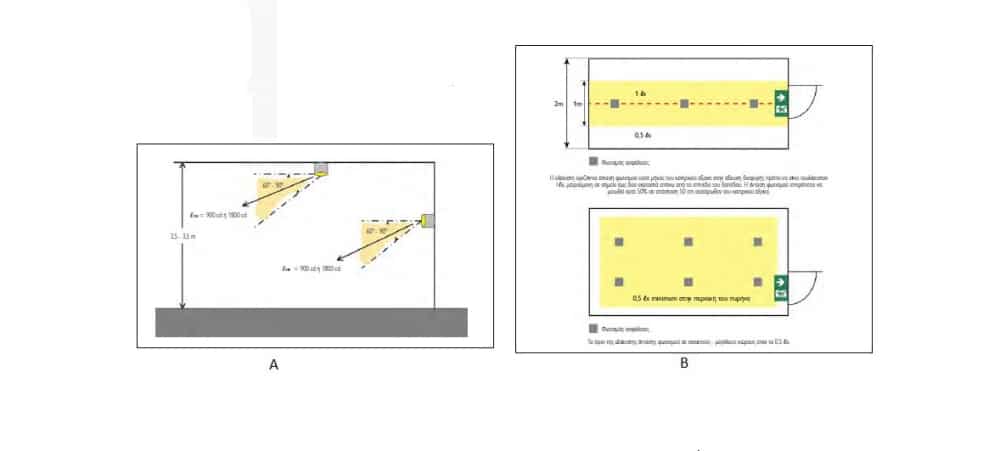
Safety lights
Escape routes need safety lighting to illuminate the critical points – areas of the space. Safety luminaires must be marked in a specific manner according to IEC 60598-2-22:2020.
The marking is made with a rectangular bar, divided into four sections, and provides coded information about the type, mode of operation, built-in equipment and rated operating time in minutes.
In the first part, the letters X or Z are written and indicate lamps with a built-in battery or powered by a central supply, respectively.
In the second part there is a number, which corresponds to the mode of operation:
• 0 (the lamps are activated only when there is a power failure),
• 1 (the lamps are constantly in operation regardless of the presence or absence of mains voltage),
• 2 (at least one of the lamps is activated only when there is a power failure),
• 3 (at least one of the lamps is constantly in operation regardless of the presence or absence of mains voltage),
• 4 (like category 0, with the possibility of supplying another lamp),
• 5 (like category 1, with the possibility of supplying another lamp) and
• 6 (the light is supplied by another security light).
In the third part it is possible to write the letters:
• A (with function test device),
• B (with mode selection),
• C (with the possibility of interrupting its operation),
• D (illuminator for high-risk areas),
• E (bulbs and/or battery not replaceable),
• F (with automatic test, according to IEC 61347-2-7),
• G (internally illuminated number plate).
The fourth part only applies to lamps with a built-in battery and the numbers 10, 60, 120 or 180 are written and indicate the operating time (in minutes) of the lamp in the event of a mains power failure
provision.
The lamp’s label must be placed on the lamp in a visible place. Marking inside the luminaire is also permitted in the case of luminaires installed in recesses. The supply voltage and IP degree of protection (against solid particles and liquids) must also be stated. The plate also indicates the IK (impact resistance) rating of the housing and the luminous flux of the luminaire in emergency mode.
A quality security light must meet the following criteria:
• Reliable performance in an emergency.
• Adapted light distribution to ensure optimal illumination of the escape point or escape route.
• Low power consumption during network and emergency operation.
• Easy installation and maintenance with correspondingly low costs.
• Possibility of recycling at the end of its life.
Emergency lights and escape signs are often on 24 hours. Light emitting diodes (LED), due to their low power and long life, are the right choice, as they contribute to low maintenance costs and energy savings.

- A. Areas of escape routes, in which the limits must not be exceeded.B. Lighting requirements defined in EN 1838 and the new technical directive of the T.E.E. for escape routes and open spaces.
– The minimum horizontal illuminance along the central axis in the escape route must be at least 1lx, measured at a point up to two centimeters above floor level. The light intensity is allowed to be reduced by 50% at a distance of 50 cm on either side of the central axis.
– The limit of the minimum light intensity in open – large spaces is 0.5 lx. - Source: https://ktirio.gr
